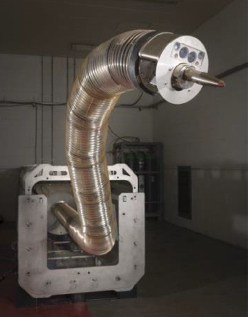
The company is merging its radiological mapping technology with virtual reality and robotics to create a new, remotely-operated platform capable of taking apart reprocessing plants at Sellafield.
The decommissioning technology is being backed by £1.5m of R&D funding from Innovate UK, including funding from the Department for Business, Energy and Industrial Strategy and the Nuclear Decommissioning Agency.
“We are combining technologies developed across different sectors of industry to deliver a breakthrough in the reduction of risks to workers, increased productivity, more efficient management of waste, reduced timescales and lower overall costs,” explained Cavendish Nuclear’s project lead Alan Rutherford.
Sellafield Ltd is looking for new technology to help it decommission the site’s nuclear fuel reprocessing complex and joined forces with the UK Government, Innovate UK and the Nuclear Decommissioning Authority to create a competition for development funding.
Cavendish Nuclear partnered with OC Robotics and applied Babcock International Group’s virtual reality capability to come up with the Sellafield In-Cell Decommissioning System (SIDS).
The short-listed system brings together three existing technologies — the robotic laser-snake arm of OC Robotics, the Radscan 3D gamma dose rate scanning technology of Cavendish Nuclear, and the virtually reality expertise of Babcock — to create a remotely-operated platform that protects workers from radiation while giving them much greater visibility of the hazards.
According to Cavendish Nuclear, the combination of radiation mapping and virtual reality simulation will allow operators to programme the sequence of robotic cutting in a way that synchronises with the site’s waste routes.
The system is being developed and tested at Cavendish Nuclear’s regional base at Westlakes, Cumbria, with a demonstration scheduled for late 2018.
The winning project — or projects — could be put to work at Sellafield’s Thermal Oxide Reprocessing Plant (THORP) and Magnox Reprocessing Plant, which are both due to close after fulfilling their operational roles.
Melanie Brownridge, head of technology at the Nuclear Decommissioning Authority, said: “It’s a huge challenge. The new integrated system must establish what’s inside the cells, measure the radioactivity, access spaces that have been sealed for years, cut up the contents (including large vessels and many miles of pipework), segregate the waste, then remove it for treatment and safe storage. Radioactivity levels are extremely high, restricting workforce access, so the work must be carried out remotely.”





Red Bull makes hydrogen fuel cell play with AVL
Formula 1 is an anachronistic anomaly where its only cutting edge is in engine development. The rules prohibit any real innovation and there would be...